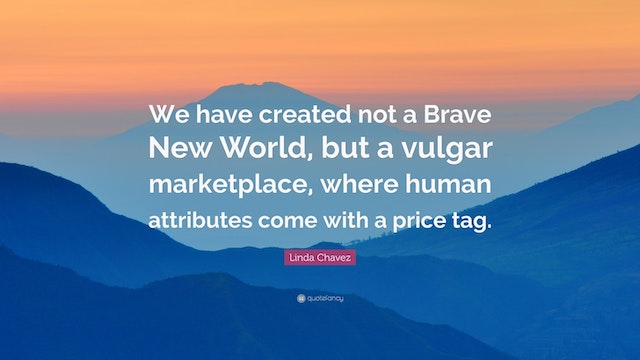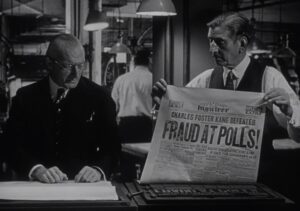 Over the last two years, I have come to realize that “journalism” and “journalists” seem to have changed in some fundamental way. I used to believe that there were standards and bedrock ethics which all journalists working for major publications ascribed to. I guess I had thought that the stereotype of the intrepid journalist toiling away in a brave and unending quest for truth was the norm (think “All the President’s Men”). But no longer. Now I feel so naive for ever believing that. What I have personally experienced, again and again, is something very different.
Over the last two years, I have come to realize that “journalism” and “journalists” seem to have changed in some fundamental way. I used to believe that there were standards and bedrock ethics which all journalists working for major publications ascribed to. I guess I had thought that the stereotype of the intrepid journalist toiling away in a brave and unending quest for truth was the norm (think “All the President’s Men”). But no longer. Now I feel so naive for ever believing that. What I have personally experienced, again and again, is something very different.
Allow me three general examples to illustrate the point…
First example. Many years ago, when I was working for the “Aeras Global Tuberculosis Vaccine Foundation” (one of the early Bill and Melinda Gates Foundation non-profit vaccine companies), the CEO hired a media consulting firm which mainly consisted of a Pulitzer-prize winning journalist and a marketing manager. To insure that favorable stories about the organization and its mission were printed, the “journalist” and the marketing specialist would consult with their clients (in this case “Aeras”), and learn what story the organization wanted to be told in a major print publication. An article pushing the story would then be crafted, all of the necessary background assembled to meet whatever editorial review standards were likely to be encountered, and this pre-baked work product would be fed to some “journalist” working for the targeted publication. Free work product, no labor required, what’s not to like? My first “you are not in Kansas any more” moment concerning modern journalism was when I saw this process used to “place” an article into “The Economist”, which I had naively believed operated as an independent arbiter of truth. Silly me.
The second example comes from having repeatedly been on the receiving end of “gotcha” journalism as it is currently practiced. “Journalists”, particularly many of the younger ones, seem to use a variety of ploys to draw out information that they can weaponize in some manner to support a pre-determined storyline that they wish to promote. Often it is a sort of confidence game, like a con artist might employ, where they flatter or use phrases like “I just want to help you to get your story out” to get the subject to let down their guard and agree to an interview. After establishing a relationship with the subject, they then draw out details using increasingly aggressive questions focused on supporting the true agenda. Often these personal details are woven into a story line designed to delegitimize someone or otherwise reveal some salacious character flaw. Then the article drops, and the naive subject suddenly finds that they have been duped into revealing personal details that have been weaponized to support a pre-determined narrative. Having experienced this myself a few times, I now often see this strategy (and various versions of this con) repeatedly play out with colleagues. As for me, lesson learned is to vet the “journalist” by reading prior work, and just say no when it becomes clear that they are a specialist in this type of strategy.
The third example comes from listening to disenchanted “old school” journalists (print and broadcast). These voices seem to be a mixture of mid-career and older practitioners, from “print” (an increasingly outdated term these days) and broadcast media. Again and again I hear various versions of the famous rant from the Oscar winning 1976 movie “Network”, where Peter Finch playing the part of “Howard Beale” says “I’m as mad as hell and I’m not going to take this any more”.
But the words I repeatedly hear from these modern versions of Howard Beale are more nuanced, and revolve around being unwilling to comply with corporate demands to mislead the public in various ways. And all tell stories of widespread soul-destroying corporate media censorship and propaganda which they just cannot tolerate anymore. This ranges from small local outlets all the way to the top stars of major networks. Basically versions of my own story – they just could no longer tolerate the ethical erosion of their chosen profession. So they take an income hit and go independent. Some succeed, others not so much. And some seem to never be able to completely leave their old reality behind. “You can take the journalist out of the New York Times, but you can’t take the New York Times out of the journalist” is one saying describing the latter.

Director Orson Welles 1941 classic “Citizen Kane”
What changed? Is the present reality any different from what has always existed, going back to the “yellow journalism” days of William Randolph Hearst (continuing with the movie theme, see “Citizen Kane”)? Trying to make sense out of the world, I started asking the “old school” journalists that I encounter what they think about this. And what I have discovered is that there is yet another insidious form of attack on our educational system, driven by the corporate interests of large “non-governmental organizations” (including the Bill and Melinda Gates foundation) which have used grants to journalism schools as a way to drive changes in how their graduates have been trained. To be blunt, this is yet another story of the gradual erosion of integrity due to the pernicious influence of massive accumulations of wealth by a few who weaponize that wealth to advance both their own power and various social agendas.
Under the influence of large “grants” (I think they would more appropriately be called “strategic investments”), many journalism schools have taken to teaching “advocacy journalism.” Which is basically a fancy term for propaganda. Apparently news media now hire journalists specifically to report with skewed biases on topics of interest to these corporations (or governments), often with corporate sponsorship. Let that sink in for a moment. The advocacy journalists are often paid by an outside organization with an agenda. So let’s figure this out what exactly is going on, starting by defining terms. The definition of advocacy journalism from Merriam-Webster is:
“journalism that advocates a cause or expresses a viewpoint”
To me, that sounds like how one might define propaganda. So, am I wrong? The definition of “propaganda” (Merriam-Webster) is:
“the spreading of ideas, information, or rumor for the purpose of helping or injuring an institution, a cause, or a person”
“ideas, facts, or allegations spread deliberately to further one’s cause or to damage an opposing cause”
 Hmmm. Very interesting. The definitions for “advocacy journalism” and propaganda are essentially THE SAME. Well, THAT is a whole lot of double speak. It is truly a Brave New World. To quote the Amazon synopsis of that classic tome, “Aldous Huxley’s profoundly important classic of world literature, Brave New World is a searching vision of an unequal, technologically-advanced future where humans are genetically bred, socially indoctrinated, and pharmaceutically anesthetized to passively uphold an authoritarian ruling order–all at the cost of our freedom, full humanity, and perhaps also our souls.” Sound familiar?
Hmmm. Very interesting. The definitions for “advocacy journalism” and propaganda are essentially THE SAME. Well, THAT is a whole lot of double speak. It is truly a Brave New World. To quote the Amazon synopsis of that classic tome, “Aldous Huxley’s profoundly important classic of world literature, Brave New World is a searching vision of an unequal, technologically-advanced future where humans are genetically bred, socially indoctrinated, and pharmaceutically anesthetized to passively uphold an authoritarian ruling order–all at the cost of our freedom, full humanity, and perhaps also our souls.” Sound familiar?
Now, why is this important? Because increasingly journalism is taught by those who believe that “classic journalism” – which required that both sides of an issue be presented, (you know – “fair and balanced”), is outdated and deserves to die a quiet death.
This is exemplified by a Wiki definition of advocacy journalism that is frankly astounding.
“Classic tenets of journalism call for objectivity and neutrality. These are antiquated principles no longer universally observed…. We must absolutely not feel bound by them. If we are ever to create meaningful change, advocacy journalism will be the single most crucial element to enable the necessary organizing. It is therefore very important that we learn how to be successful advocacy journalists. For many, this will require a different way of identifying and pursuing goals.”
So, who teaches “advocacy journalism”, and who funds such teachings?
Well, for starters – let’s go to one of the premier journalism schools in the USA – Columbia University. How do they view “advocacy journalism”? At Columbia University, one of their programs proudly announces the following:
“CALLING FOR COALITIONS: BUILDING PARTNERSHIPS BETWEEN JOURNALISTS AND ADVOCATES
Journalism is being hit hard globally, and some even predict the end of independent journalism in the global south, especially in Africa. It’s time to look at what may survive. Philanthropic funding will become more essential, and donors will be eager to expand partnerships between journalism and advocacy groups. Through this project, the Bill & Melinda Gates Foundation’s Media Partnerships team explored the dynamics of such collaborations. Drawing from multiple case studies, the project provided recommendations for foundations, nonprofits and media organizations that maximize impact, respecting a shared covenant.”
 Their partner in developing advocacy journalism training programs, with the expansion of such funding is… the Bill & Melinda Gates Foundation. Unbelievable.
Their partner in developing advocacy journalism training programs, with the expansion of such funding is… the Bill & Melinda Gates Foundation. Unbelievable.
But now there is a new “style” of journalism that has become quite the fad. This subset of advocacy journalism is called “solutions journalism”, and it is the term that the Bill & Melinda Gates Foundation like to use for their funding mechanisms to influence governments, citizens and leaders. Of course advocacy journalism is basically a “nicer, kinder” form of propaganda… Right? You know like when people call censorship – “cancel culture.” Because cancel culture sounds so much “nicer” than censorship… After all, what Twitter, Linked-in and You Tube are doing by banning people and content is for all “our” benefit, right?
 Speaking plainly, what these modern media companies are doing is really a form of book burning. See Ray Bradbury’s masterpiece Fahrenheit 451 for further on that.
Speaking plainly, what these modern media companies are doing is really a form of book burning. See Ray Bradbury’s masterpiece Fahrenheit 451 for further on that.
Large donors or sponsors are giving money to media corporations to bias reporting via “solutions journalism”. And clearly various governments are also influencing what is allowed to be discussed and in what ways. For further on that, see our prior substack concerning the “Overton Window”. These sponsors can be non-governmental organizations, or also governments or global non-govermental organizations such as the Zuckerberg-Chan initiative, Bill and Melinda Gates Foundation, United Nations, World Health Organization or World Economic Foundation. These groups seek out “private-public” partnerships (which, as previously noted, is basically another euphemism for what Benito Mussolini defined as Fascism). And they seek these relationships by using advocacy journalism – propaganda to sway public opinion. Sometimes they even fund specific investigations. When this happens, who is compromised? Clearly, Truth and Integrity are immediate casualties. All for the greater good of the greatest number of people, of course. As defined by the organization giving the money.
Conflict of Interest? Bill Gates Gave $319 Million to Major Media Outlets, Documents Reveal. The defender November, 2021.
“According to MintPress News, the Bill & Melinda Gates Foundation donated at least $319 million to fund media projects at hundreds of organizations including CNN, NBC, NPR, PBS and The Atlantic, raising questions about those news outlets’ ability to report objectively on Gates and his work.”
It is important to realize that biases and opinions have always been a part of journalism. Generally, we previously called these pieces “editorials”. When editorials are grouped together, they used to form the “opinion page.” An antiquated term, I know. Of course, we all know that some newspapers are “liberal” and some “republican.” Of course biases do creep into reporting and in fact, every newspaper’s reputation is built on those biases.
But this is different. This is allowing a non-profit governmental organization (at best), a corporation or government (at worst) to control the content of a newspaper or magazine through secret hand-shakes, grants and contracts. It is allowing psy-ops operations a front row seat into influencing the minds of the reader. This is a whole other ball-game, and it needs to stop or at the very least, be called out and recognized for what it is: corporate and state-sponsored propaganda.
Advocacy journalists can and are influenced by governmental policies. For instance, the NY Times recently described a new hire as “joining The New York Times as a technology reporter covering disinformation and all of its tentacles.” The pejorative use of the word “tentacles” pretty much shows what biases the new reporter is expected to have. The implication being that information not disseminated by the US government is disinformation, whether the topic be on climate change, diversity, elections, physician’s right to try or infectious disease. BTW: Any one else notice how the disinformation list keeps growing longer?
How does the Trusted News Initiative (TNI) or global information control fit into the campaign against “disinformation’? The TNI is basically a treaty management organization managed by the British Broadcasting Corporation which uses advocacy journalism to control content of news media through out the “free” world. Does this mean that only that “news” or PR spin which a government or world body wishes to be advanced can be allowed to be published or electronically distributed in some way? Advocacy journalism which promotes a certain viewpoint fits right in with the TNI model.
The long strange evolution of the TNI, from election interference to COVID-19 total information management shows the extent to which power corrupts, and that those being corrupted often have no idea that they are being corrupted. “Journalists” who are trained or coopted into buying into the idea that there is “one truth,” one right answer, and that governments are honest brokers in the assessment of that truth are not “fair and balanced”. They are naive and dangerous. Governments do lie, and what they offer as truth is often better termed mis- dis- and mal- information. Which is precisely why advocacy journalism (ergo propaganda) is dangerous. In a democracy, if an electorate is to be able to make appropriately informed choices, the news must be free from government (and corporate interest group) interference, reported from all angles, from all points of view – not just one narrow reading of the “truth”, as presented by big brother.
The problem is that this truly is a slippery slope. How does a newspaper or content provider determine what propaganda is “good” or “bad”? How is disinformation determined? Does the government get to decide? The “Trusted News Initiative” leadership? What about the Bill and Melinda Gates Foundation, are they to be the arbiters of truth?
Should a newspaper, magazine, or broadcaster try to make a determination about the impact on objectivity before accepting funds or making commitments to the government? Once upon a time (note the fairy tale prelude) most “established” legacy media tried to maintain a firewall between their “news” and “op-ed” operations. How antiquated that now seems. Does the organization being paid to present one point of view have an obligation to be transparent? To disclose conflicts of interest? Do they need to provide the public with the contract, the information on how they are being paid to bias the news they are reporting, their relationship with the TNI, etc.? What happens when the information control comes in the form of stopping certain types of mis- dis- or mal- information that the government doesn’t want reporters to write on? Or threatens to label those who communicate such as domestic terrorists? What happens when the sponsor wants the advocacy journalism to include marketing campaigns that basically target individuals viewed as opposition? Does the newspaper have an obligation to inform the public that they are being nudged? The ethical morass that this type of journalism creates is huge. All we can hope is that institutions teaching journalism begin to recognize the dangers of promoting advocacy or solutions journalism and return back to the classic tenets of journalism, those being objectivity and neutrality. And restore integrity to the discipline.
LATE BREAKING…
And now, thanks to a FOIA request from BLAZE media, we know that the US Government has paid over a billion US dollars to the legacy media to promote advertising propaganda about the COVID vaccines as safe and effective.
In response to a FOIA request filed by TheBlaze, HHS revealed that it purchased advertising from major news networks including ABC, CBS, and NBC, as well as cable TV news stations Fox News, CNN, and MSNBC, legacy media publications including the New York Post, the Los Angeles Times, and the Washington Post, digital media companies like BuzzFeed News and Newsmax, and hundreds of local newspapers and TV stations. These outlets were collectively responsible for publishing countless articles and video segments regarding the vaccine that were nearly uniformly positive about the vaccine in terms of both its efficacy and safety.
 Hundreds of news organizations were paid by the federal government to advertise for the vaccines as part of a “comprehensive media campaign,” according to documents TheBlaze obtained from the Department of Health and Human Services. The Biden administration purchased ads on TV, radio, in print, and on social media to build vaccine confidence, timing this effort with the increasing availability of the vaccines. The government also relied on earned media featuring “influencers” from “communities hit hard by COVID-19” and “experts” like White House chief medical adviser Dr. Anthony Fauci and other academics to be interviewed and promote vaccination in the news.
Hundreds of news organizations were paid by the federal government to advertise for the vaccines as part of a “comprehensive media campaign,” according to documents TheBlaze obtained from the Department of Health and Human Services. The Biden administration purchased ads on TV, radio, in print, and on social media to build vaccine confidence, timing this effort with the increasing availability of the vaccines. The government also relied on earned media featuring “influencers” from “communities hit hard by COVID-19” and “experts” like White House chief medical adviser Dr. Anthony Fauci and other academics to be interviewed and promote vaccination in the news.
Welcome to 21st century media warfare. Waged by our government on you.
The Biden administration engaged in a massive campaign to educate the public and promote vaccination as the best way to prevent serious illness or death from COVID-19.
Congress appropriated $1 billion in fiscal year 2021 for the secretary of health to spend on activities to “strengthen vaccine confidence in the United States.” Federal law authorizes HHS to act through the U.S. Centers for Disease Control and Prevention and other agencies to award contracts to public and private entities to “carry out a national, evidence-based campaign to increase awareness and knowledge of the safety and effectiveness of vaccines for the prevention and control of diseases, combat misinformation about vaccines, and disseminate scientific and evidence-based vaccine-related information, with the goal of increasing rates of vaccination across all ages … to reduce and eliminate vaccine-preventable diseases.”
Written by Robert W Malone MD, MS for His Blog ~ March 5, 2022
